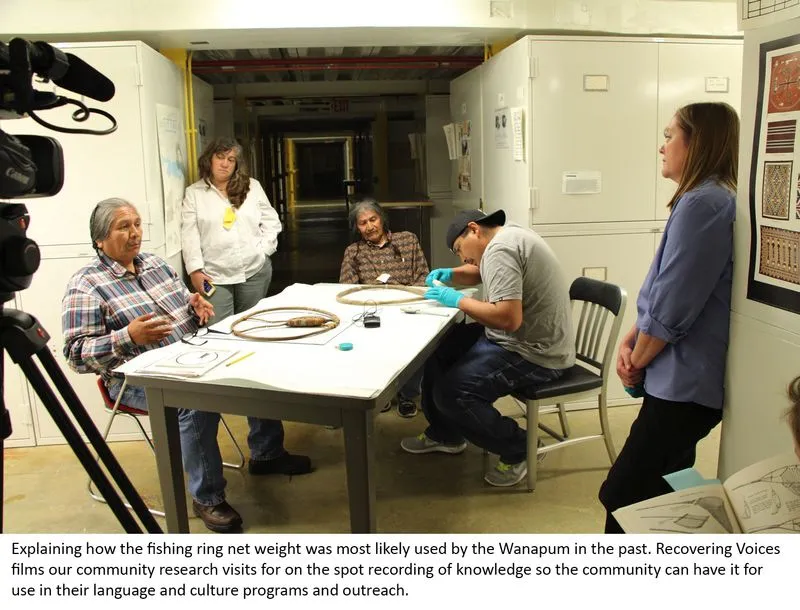
Search

News from Recovering Voices
Wanapum Technology in the Smithsonian Collections: Two Fishing Ring Net Weights
By: Judith Andrews
05/26/2015

It is not every day that you work to reintegrate old technology into the new ways of doing something, but that is just what Recovering Voices’ most recent community researchers are doing. The Wanapum Band of Priest Rapids has a long history and tradition of feeding their families from the Columbia River and surrounding lands. This tradition was interrupted by the Manhattan Project in the 1940s when the U.S. government relocated the tribe in order to build nuclear facilities in the area that had been traditional Wanapum fishing territory. The Smithsonian Institution now holds in its collections two of the last four* known fishing ring net weights that had been used by the Wanapum. A third was recently donated to the Burke Museum of Natural History and Culture in Seattle, WA.
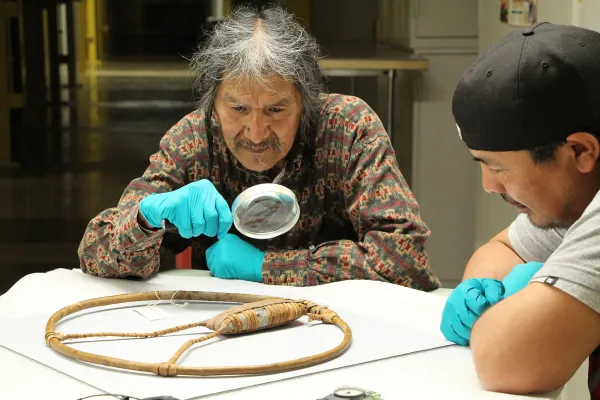
During their research visit to the Smithsonian on April 20-22, the group was able to study the fishing ring net weights for the purpose of learning how to make these again and determine how they work to weigh down drift nets for gill fishing. Through complex engineering, the weight of the stone suspended in the center of the ring balances against the buoyancy of the wood. The tension of the ring’s binding also allows it to withstand repeated impact as it moves along the bottom of the river bed as the net moves down river with the current. This technology is specifically designed to keep the bottom section of the net weighted down while not catching on rocks at the bottom of the river.
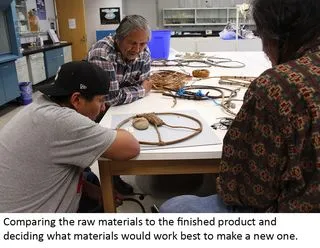
Replicating something from a photograph is a challenging prospect. With this in mind the group from Wanapum requested to spend three days with these objects, in order to carefully study the techniques, and materials used in their manufacture. They examined the collections objects to determine the type of raw materials. They asked, what kinds of knots were used? Were the materials gathered at a certain time of year? How long does it take to cure or process the raw material before it is ready? Were the plants used mature or young? Before coming to the Smithsonian, the group was able to view a fishing ring net weight in collections at the Burke Museum. This recent donation is in poor condition compared to the two at the Smithsonian, but viewing it in a state of disrepair presented the group with a multitude of information on the materials. Prior to their visit, the group collected a variety of potential materials that might have been used to make the object. These were sent to the Smithsonian ahead of the planned visit. NMNH collections staff then gradually froze and unfroze the raw materials to ensure no bugs or pests made the journey across the country and were able to have the raw materials ready to work with when the group arrived.
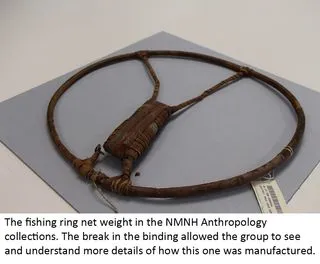
This preparation paid off. The group was able to directly compare raw materials with the fishing ring net weight in the Anthropology collections at the National Museum of Natural History’s Museum Support Center. But even this fishing ring net weight was in disrepair in comparison to the one held by the National Museum of the American Indian. After spending time with the fishing technology in the Anthropology collections and working on making wooden rings and comparing materials, the group visited the Cultural Resources Center of the National Museum of the American Indian and finally were able to pick up by hand an unbroken fishing ring net weight.
As the group heads back to Washington with newfound knowledge and a new relationship with the fishing ring net weights at the Smithsonian, they plan to continue working with the raw materials to determine how to replicate these objects. It will take time to relearn the correct processing for preparing the raw materials to reawaken this technology and incorporate it back into their fishing methods.
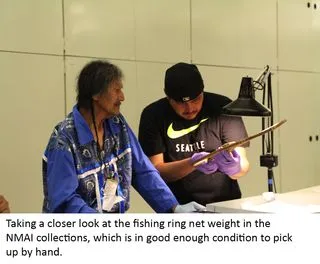
This research visit was also highly informative for the Smithsonian. In the past, as items have been donated to the Smithsonian collections, the traditional terminology and names may have been lost. This was the case for the fishing ring net weight. The Anthropology catalog record listed it as a wooden hoop and some called it a fish wheel. Consultations with the group concluded that a true fish wheel is approximately the size of a small room. Under this definition these are not fish wheels, they are also not simply net sinkers, weights or anchors, which are generally rocks that would weigh down a net and keep it in a certain place. The fishing ring net weight is engineered to allow the net to move with the current while keeping the net submerged but not on the bottom of the riverbed. Much consideration by the group went into the new terminology that will now better describe these objects and their use when listed in the museum catalog.
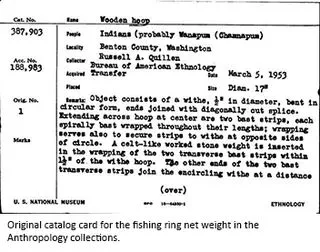
Anthropology collections.
Maybe you’ve seen one of these and not known what it was or what it was called. We only know about four today, but there are potentially many more that were found and collected along the Columbia River after the tribe was forced to move from their traditional lands. This technology is an important piece of the Wanapum’s long tradition of fishing. We also learned through this visit that it is difficult to find technology when it enters the collections record under an inexact name. We hope more Wanapum fishing ring net weights will come to light in the future.
*A fourth net ring weight was recently found by the group at Central Washington University.